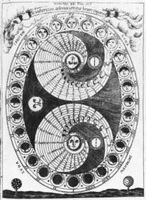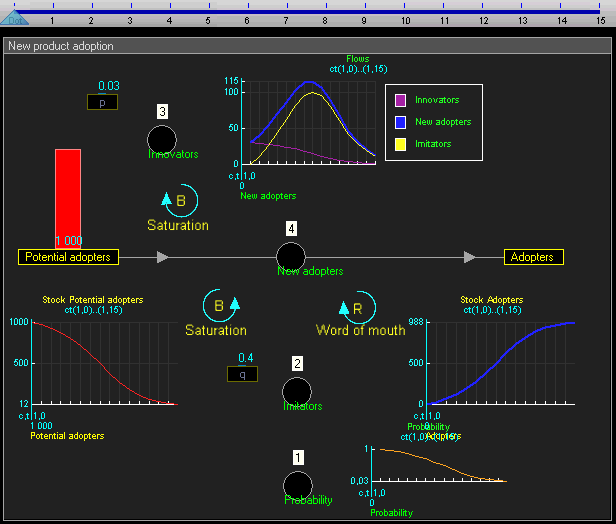Dynamic
Definition
Adjective
- 1. Of or pertaining to force producing motion: often opposed to static.
- 2. Of or pertaining to force in action or operation; active.
- 3. transf. and fig. a. Active, potent, energetic, effective, forceful.
- b. Opposed to static.
- 4. Of, according to, or pertaining to the science of DYNAMICS: as the dynamic theory of the tides.
- 5. Med. a. Functional, in contradistinction to organic; as in dynamic disease. b. With Hahnemann and his followers: Of the nature of some immaterial or ‘spiritual’ influence. c. Attended with a morbid increase of vital action, sthenic (obs.).
- 6. In the Kantian philosophy: Relating to the reason of existence of an object of experience.
dynamic relations, the relations between objects as forming parts of one connected experience: viz. the relations of substance and accident, of cause and effect, and of substances acting upon each other. dynamic category, a category that expresses one of the dynamic relations. dynamic synthesis, a synthesis which is guided by the dynamic categories.
- 7. Relating to the existence or action of some force or forces; applied esp. to a theory that accounts for matter, or for mind, as being merely the action of forces: see DYNAMISM 1. dynamic theory of Kant, a theory according to which matter was conceived to be constituted by two antagonistic principles of attraction and repulsion.
- 8. Mus. Of, pertaining to, or indicating the volume of sound from a musical instrument or in a musical performance. Also transf.
- 9. dynamic braking = electric braking; dynamic equator (see quot. 1883); dynamic metamorphism (also dynamical m.) Geol., metamorphism produced by mechanical forces; dynamic pressure, the pressure in a fluid that is due to its motion.
Psychodynamics
Psychodynamics is the systematized study and theory of the psychological forces that underlie human behavior, emphasizing the interplay between unconscious and conscious motivation.[1]
The original concept of "psychodynamics" was developed by Sigmund Freud.[2] Freud suggested that psychological processes are flows of psychological energy in a complex brain, establishing "psychodynamics" on the basis of psychological energy, which he referred to as libido.
The psychodynamic psychotherapy is a less intensive form compared to classical psychoanalysis practiced by strict Freudians, demanding sessions only once weekly instead of 3-5 times weekly which was typical for traditional psychoanalysts.
Psychodynamic therapies depend on a theory of inner conflicts which surface in behaviour or emotions. Generally, one conflict is subconscious.[3]
Overview
In general, psychodynamics, also known as dynamic psychology, is the study of the interrelationship of various parts of the mind, personality, or psyche as they relate to mental, emotional, or motivational forces especially at the unconscious level.[4][5][6] The mental forces involved in psychodynamics are often divided into two parts:[7] (a) interaction of emotional forces: the interaction of the emotional and motivational forces that affect behavior and mental states, especially on a subconscious level; (b) inner forces affecting behavior: the study of the emotional and motivational forces that affect behavior and states of mind;.
Freud proposed that psychological energy was constant (hence, emotional changes consisted only in displacements) and that it tended to rest (point attractor) through discharge (catharsis).[8] In mate selection psychology, psychodynamics is defined as the study of the forces, motives, and energy generated by the deepest of human needs.[9]
In general, psychodynamics studies the transformations and exchanges of "psychic energy" within the personality.[5] A focus in psychodynamics is the connection between the energetics of emotional states in the id, ego, and superego as they relate to early childhood developments and processes. At the heart of psychological processes, according to Freud, is the ego, which he envisions as battling with three forces: the id, the super-ego, and the outside world.[4] Hence, the basic psychodynamic model focuses on the dynamic interactions between the id, ego, and superego.[10] Psychodynamics, subsequently, attempts to explain or interpret behavior or mental states in terms of innate emotional forces or processes. [1]
System Dynamics
System dynamics is an approach to understanding the behaviour of complex systems over time. It deals with internal feedback loops and time delays that affect the behaviour of the entire system.[1] What makes using system dynamics different from other approaches to studying complex systems is the use of feedback loops and stocks and flows. These elements help describe how even seemingly simple systems display baffling nonlinearity.
Overview
System dynamics is a powerful methodology and computer simulation modeling technique for framing, understanding, and discussing complex issues and problems. Originally developed in the 1950s to help corporate managers improve their understanding of industrial processes, system dynamics is currently being used throughout the public and private sector for policy analysis and design.[2]
System dynamics is an aspect of systems theory as a method for understanding the dynamic behavior of complex systems. The basis of the method is the recognition that the structure of any system — the many circular, interlocking, sometimes time-delayed relationships among its components — is often just as important in determining its behavior as the individual components themselves. Examples are chaos theory and social dynamics. It is also claimed that because there are often properties-of-the-whole which cannot be found among the properties-of-the-elements, in some cases the behavior of the whole cannot be explained in terms of the behavior of the parts.[2]
Reference Notes
- MIT System Dynamics in Education Project (SDEP)
- Robert A. Taylor (2008). "Origin of System Dynamics: Jay W. Forrester and the History of System Dynamics". In: U.S. Department of Energy's Introduction to System Dynamics. Retrieved 23 Oktober 2008.
- What is psychodynamics? - WebMD, Stedman’s Medical Dictionary 28th Edition, Copyright© 2006_Lippincott Williams & Wilkins.
- Bowlby, John (1999). Attachment and Loss: Vol I, 2nd Ed.. Basic Books. pp. 13–23. ISBN 0-465-00543-8.
- Adapted from Corsini and Wedding 2008; Corsini, R. J., & Wedding, D. (2008) Current Psychotherapies, 8th Edition. Belmont, CA.: Thomson Brooks/Cole. (pp. 15-17).
- Freud, Sigmund (1923). The Ego and the Id. W.W. Norton & Company. pp. (4–5). ISBN 0-393-0042-3.
- Hall, Calvin, S. (1954). A Primer in Freudian Psychology. Meridian Book. ISBN 0452011833.
- Psychodynamics (1874) - (1) the psychology of mental or emotional forces or processes developing especially in early childhood and their effects on behavior and mental states; (2) explanation ! or interpretation, as of behavior or mental states, in terms of mental or emotional forces or processes; (3) motivational forces acting especially at the unconscious level. Source: Merriam-Webster, 2000, CD-ROM, version 2.5
- Psychodynamics – Microsoft Encarta
- Robertson, Robin; Combs, Allan (1995). Chaos theory in Psychology and Life Sciences. LEA, Inc.. p. (83). ISBN 0805817379.
- Klimek, David (1979). Beneath Mate Selection and Marriage - the Unconscious Motives in Human Pairing. Van Nostrand Reinhold. p. 3. ISBN 0-442-23074-5.
- Ahles, Scott, R. (2004). Our Inner World: A Guide to Psychodynamics and Psychotherapy. John Hopkins University Press. pp. (1–2). ISBN 0801878365.
- Horowitz, Mardi, J. (1988). Introduction to Psychodynamics - a New Synthesis. Basic Books. p. 3. ISBN 0-465-03561-2.
- Berne, Eric (1964). Games People Play – The Basic Hand Book of Transactional Analysis. New York: Ballantine Books. ISBN 0-345-41003-3.
- Walsh, Anthony (1991). The Science of Love - Understanding Love and its Effects on Mind and Body. Buffalo, New York: Prometheus Books. p. 58. ISBN 0-87957-648-9.
- Hall, Calvin S.; Nordby, Vernon J. (1999). A Primer of Jungian Psychology. New York: Meridian. ISBN 0-452-01186-8.
- niu.edu Outline of the Major Points in Carl Jung's Contributions to Psychology
- Csikszentmihalyi, Mihaly (1990). Flow: The Psychology of Optimal Experience. (pgs. 4,6). New York: Harper and Row. ISBN 0-06-092043-2
- Marsh, Ann. (2005). “The Art of Work” Fast Company, Issue 97, August, pg. 76.
- Psychodynamics - an Introduction
- Horowitz, Mardi, J. (2001). Cognitive Psychodynamics – from Conflict to Character. Wiley. ISBN 0471117722.
Further reading
- Forrester, Jay W. (1961). Industrial Dynamics. Pegasus Communications. ISBN 1883823366.
- Forrester, Jay W. (1969). Urban Dynamics. Pegasus Communications. ISBN 1883823390.
- Meadows, Donella H. (1972). Limits to Growth. New York: University books. ISBN 0-87663-165-0.
- Morecroft, John (2007). Strategic Modelling and Business Dynamics: A Feedback Systems Approach. John Wiley & Sons. ISBN 0470012862.
- Roberts, Edward B. (1978). Managerial Applications of System Dynamics. Cambridge: MIT Press. ISBN 026218088X.
- Randers, Jorgen (1980). Elements of the System Dynamics Method. Cambridge: MIT Press. ISBN 0915299399.
- Senge, Peter (1990). The Fifth Discipline. Currency. ISBN 0-385-26095-4.
- Sterman, John D. (2000). Business Dynamics: Systems thinking and modeling for a complex world. McGraw Hill. ISBN 0-07-231135-5.
- Brown, Junius Flagg & Menninger, Karl Augustus (1940). The Psychodynamics of Abnormal Behavior, 484 pages, McGraw-Hill Book Company, inc.
- Weiss, Edoardo (1950). Principles of Psychodynamics, 268 pages, Grune & Stratton
Pearson Education (1970). The Psychodynamics of Patient Care Prentice Hall, 422 pgs. Standford University: *Higher Education Division.
- Jean Laplanche et J.B. Pontalis (1974). The Language of Psycho-Analysis, Editeur: W. W. Norton & Company, ISBN 0-393-01105-4
- Raphael-Leff, Joan (2005). Parent Infant Psychodynamics – Wild Things, Mirrors, and Ghosts. Wiley. ISBN 1-86156-346-9.
External links
- U.S. Department of Energy's Introduction to System Dynamics
- Desert Island Dynamics "An Annotated Survey of the Essential System Dynamics Literature"
- The Psychodynamics of Political Correctness
- Psychodynamics & Large Groups

